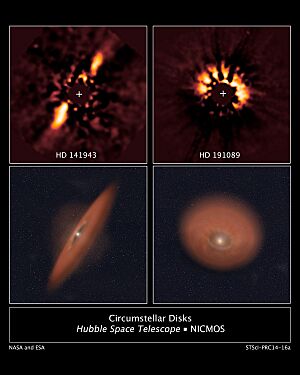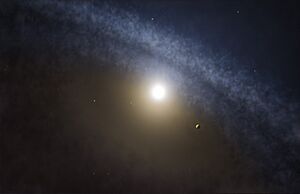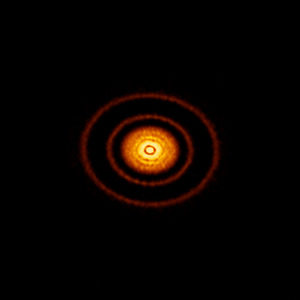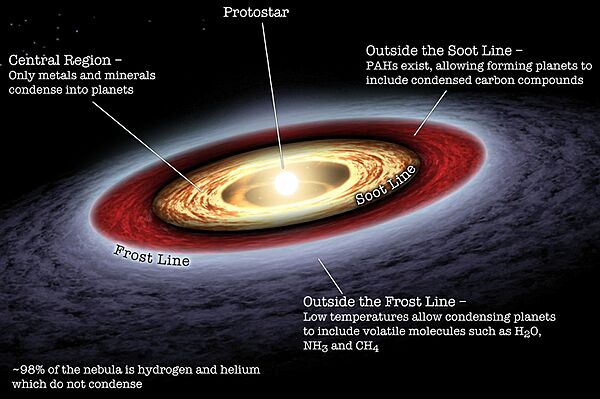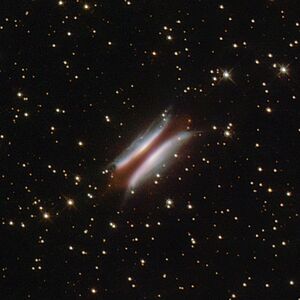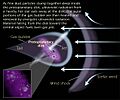Circumstellar disc facts for kids
A circumstellar disc is like a giant, flat, spinning pancake or ring made of gas, dust, and small space rocks. It orbits around a star.
Around very young stars, these discs are where planets are born! They hold all the building blocks for new worlds. Around older stars, they can show that planets have already formed. Even around dead stars called white dwarfs, these discs can exist, meaning some planetary material survived the star's life.
Contents
Young Stars and Planet Building
When a new star forms, it starts as a big cloud of gas and dust that collapses. As it collapses, it spins faster, like a figure skater pulling in their arms. This spinning flattens the cloud into a disc around the baby star. This disc is called a protoplanetary disc.
This disc is mostly gas, but it also has tiny dust grains. Over millions of years, these dust grains bump into each other and stick together. They grow bigger and bigger, forming small rocks, then larger objects called planetesimals. If there's enough material, these planetesimals keep growing, eventually forming planets! Scientists believe that planetary systems, like our own Solar System, naturally form from these discs around young stars.
Discs in Our Solar System
Our own Solar System has several disc-like areas:
- The asteroid belt is a region between Mars and Jupiter. It's full of small, rocky bodies called asteroids.
- The Edgeworth-Kuiper belt is a cold, icy region beyond Neptune's orbit. It's home to many dwarf planets and comets.
- The Scattered disc is even further out than the Kuiper Belt. It has icy bodies scattered by Neptune's gravity.
- The inner part of the Oort cloud is also shaped like a torus (a donut). This cloud is a huge shell of icy objects far beyond the planets.
Discs Around Two Stars
When two stars orbit each other, they form a binary system. Gas falling towards these stars can also create discs.
- A circumprimary disc orbits the bigger star in the pair.
- A circumsecondary disc orbits the smaller star.
- A circumbinary disc orbits around both stars, like a giant ring enclosing the whole binary system. This type of disc has a big empty space in the middle, around the two stars.
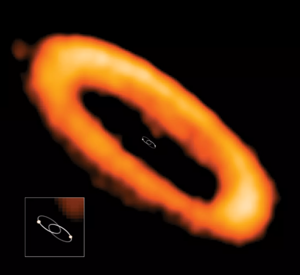
Dusty Discs
Some discs are mostly made of dust:
- Debris discs are like dusty leftovers from planet formation. They contain small rocks and dust created by collisions between larger objects, like asteroids or comets. The gas from the original disc has mostly disappeared.
- The Zodiacal cloud is the dust in our Solar System. It's made from asteroid collisions and evaporating comets. You can sometimes see its light as a faint glow in the sky before sunrise or after sunset.
- Exozodiacal dust is similar dust found around other stars.
Stages of Disc Life
Circumstellar discs change over time. Scientists describe their evolution in stages:
- Protoplanetary discs: These are the youngest discs. They have lots of gas and dust and are massive enough to form planets.
- Transition discs: These discs are in between protoplanetary and debris discs. They have less gas and dust, and often have large empty spaces or holes in their middle.
- Debris discs: These are older, very thin discs, mostly made of dust with little to no gas. The dust in these discs is constantly being replaced by new dust from collisions.
How Discs Disappear
Circumstellar discs don't last forever. The material in them slowly disappears over time. This process is called dissipation.
- One way discs dissipate is through grain growth. Tiny dust particles stick together to form larger objects, which then become planets or planetesimals.
- Another way is photoevaporation. Powerful light and winds from the central star can blow away the gas and dust.
- Sometimes, a giant planet forming within the disc can also clear out material around it.
Scientists study how fast discs dissipate to understand how long it takes for planets to form. For example, transition discs, which have big holes, suggest that discs can disappear in about 10 million years on average.

Taking Pictures of Discs
Scientists can take direct images of protoplanetary and debris discs using powerful telescopes.
- If a disc is seen edge-on (like a thin line), it can sometimes block the star's light, making the disc easier to see. Examples include Gomez's Hamburger.
- For other discs, special tools like a coronagraph (which blocks the bright star's light) or adaptive optics (which correct for blurry effects from Earth's atmosphere) are needed.
- Optical and infrared telescopes, like SPHERE, capture light scattered by tiny dust particles on the disc's surface.
- Radio telescopes, like the ALMA, can detect larger, millimeter-sized dust grains in the middle of the disc. They can also see gas in the disc and measure how fast it's moving.
- Sometimes, an edge-on disc can cast a huge shadow onto the surrounding material, making the disc appear much larger than it really is.
See also
 In Spanish: Disco circunestelar para niños
In Spanish: Disco circunestelar para niños
- List of resolved circumstellar disks
- List of transiting circumsecondary disks
- Accretion disk
- Circumstellar envelope
- Disrupted planet
- Exoasteroid
- Exoplanet
- Formation and evolution of the Solar System
- Peter Pan disk
- Tabby's Star − oddly dimming star
- WD 1145+017 - star destroying planetesimal, producing a dusty disk
Images for kids


